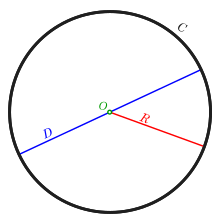A radius is a line segment that extends from the center of a circle or sphere to its perimeter. It’s the fundamental measure that defines these shapes, determining their size and properties. The word “radius” comes from the Latin word for “ray,” which paints a vivid picture of how these lines radiate out from the center.
Radius Defines Circle Properties
The radius is the building block for understanding circles. It’s typically denoted by the letter ‘r’ in mathematical formulas. With just this one measurement, we can calculate a circle’s circumference (C = 2πr) and area (A = πr²). It’s like having a master key that unlocks all of a circle’s secrets.
Diameter: The Radius’s Double
The diameter of a circle is twice its radius. This relationship is so fundamental that you can think of the radius as the diameter’s better half. When you see a circle’s diameter, you can quickly find its radius by dividing by two. It’s a handy shortcut that comes in useful more often than you might think.
Radius in Regular Polygons
Circles don’t have a monopoly on radii. In regular polygons, the radius is the distance from the center to any vertex. For example, in a regular hexagon, you can draw six equal radii from the center to each corner. These radii form the spokes of an imaginary wheel, showcasing the polygon’s symmetry.
Radius in Three Dimensions
When we step into the third dimension, the radius concept expands to spheres. Here, it’s the distance from the center to any point on the surface. Imagine blowing up a balloon – the radius is how far the surface stretches from the center as it inflates.
Radius in Real-World Applications
The concept of radius isn’t just for math class. It’s crucial in engineering, architecture, and even everyday life. When you’re setting up a circular table for a party, you’re using the radius to figure out how much space you need. Engineers use radii to design everything from gears to satellite dishes.
Calculating Radius: From Simple to Complex
For a basic circle, if you know the circumference, you can find the radius using the formula r = C / (2π). But things get more interesting with three points in space. If you have the coordinates of three non-collinear points, you can calculate the radius of the circle that passes through them using a more complex formula involving sines and differences in coordinates.
Radius might seem like a simple concept, but it’s a powerful tool in geometry and beyond. From the circles we draw as kids to the orbits of planets, the radius helps us understand and measure the curved world around us.
Citations:
In classical geometry, a radius (pl.: radii or radiuses) of a circle or sphere is any of the line segments from its center to its perimeter, and in more modern usage, it is also their length. The radius of a regular polygon is the line segment or distance from its center to any of its vertices. The name comes from the Latin radius, meaning ray but also the spoke of a chariot wheel. The typical abbreviation and mathematical symbol for radius is R or r. By extension, the diameter D is defined as twice the radius:

If an object does not have a center, the term may refer to its circumradius, the radius of its circumscribed circle or circumscribed sphere. In either case, the radius may be more than half the diameter, which is usually defined as the maximum distance between any two points of the figure. The inradius of a geometric figure is usually the radius of the largest circle or sphere contained in it. The inner radius of a ring, tube or other hollow object is the radius of its cavity.
For regular polygons, the radius is the same as its circumradius. The inradius of a regular polygon is also called apothem. In graph theory, the radius of a graph is the minimum over all vertices u of the maximum distance from u to any other vertex of the graph.
The radius of the circle with perimeter (circumference) C is



